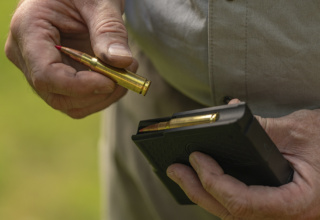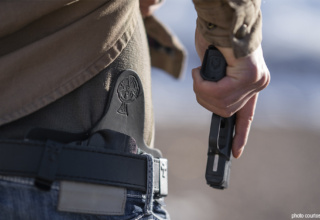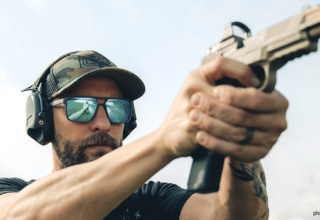Civil unrest, natural disasters, unforeseen shutdowns… many things can prevent you from getting home to your family in an emergency. Here is what you need with you at all times.
by Rob Reaser
You have probably heard of “bug out” and “bug home” bags. A good idea? Absolutely. But the day-to-day reality is you may not always have a go bag with you. A proper go bag is all about having the gear and supplies you need to survive several days on foot until you can get to a safe haven or the condition that forced you to flee has been neutralized. Such a go bag is not something you would carry with you to the office, the job site, or wherever your daily routine takes you.
For prepared everyday living, what you need is an essentials bag that is ALWAYS with you.
Being stranded without means is a frightful notion, but it is a concept most people never consider. With the disruptions facing us today courtesy of the global pandemic, we can never know when or where we may be faced with a situation that prevents us from, say, simply getting back home.
Think that possibility is a bit “out there?” Think again. We need only to roll our memory back to September 11, 2001, the day jihadi terrorists slammed commercial airliners into New York’s Twin Towers and the Pentagon. The images of Manhattan workers fleeing downtown with only the clothes on their backs, trying to get safe and get home in a city reduced to pure chaos is burned in our minds. Then there are the natural disasters like hurricane Katrina, which delivered New Orleans a fatal blow that put unprotected and unprepared citizens on the largely lawless streets to find their way out.
The point is, we never know when we may be forced to abandon conventional transportation in order to make it back home to our families—blackouts that drop the power grid, a tornado cluster that shuts the roadways, or maybe something as simple as a vehicle breakdown miles from help or phone service. We just never know where an adverse situation will find us, so it is only reasonable that we stay prepared to get home safely.
The best way to ensure that happens is to develop your own get-home bag, but one that you can take with you wherever you go. To do that, you need to consider the essentials needed to survive an on-foot trek from wherever you are to wherever you need to be. That may only be a half-hour’s walk, or it may be a two-day journey on foot. You also must consider that your get-home gear should be conveniently kept with you all the time. That means it must be discrete and comfortable to carry. Here is what we are talking about…
Go Everywhere Bag
For a couple years now, we have been using the Business Pack from ALPS OutdoorZ for our work travel. Whether heading to the office, trade shows, or visiting our friends in the outdoor and shooting industry, we have enjoyed the Business Pack’s multi-pocket design, ample storage capacity for a laptop, notebooks…basically everything you need for your mobile office. Another cool design feature of the Business Pack is that it includes ergonomic shoulder straps and a sternum strap. When the load is heavy, you can throw the pack over your shoulder or carry it like a backpack. And since ALPS OutdoorZ is the expert in manufacturing extreme wilderness hunting packs, the Business Pack shares the same quality of manufacturing, intelligent design, and rugged construction as its hunting-oriented counterparts.
For us, the only thing lacking was a convenient means of carrying a handgun and ammo. After considerable thinking and investigating options, we came across a solution (more on that in a moment).
Although we are sure ALPS OutdoorZ did not have a get-home bag in mind when they developed the Business Pack, it is actually perfect for that purpose. Multiple zippered pockets, ample storage capacity, and three carry modes—handle, over-shoulder sling, and shoulder straps—make this a casual office “briefcase” that doubles as a backpack capable of carrying the essentials you need in an emergency.
Protection
If you are a frequent reader of Shoot On, we do not need to tell you the importance of being armed to defend yourself and your family at all times. For those of you who are new to firearms and maybe have picked up your first handgun due to safety concerns surrounding the current pandemic, we are here to tell you that personal safety is not a subject limited to the home front. That handgun cannot protect you if it is locked away in a dresser drawer and you are ten miles from home. Get the training you need, become comfortable and proficient with your handgun, and obtain a CCW permit (or whatever your state/local laws require to carry a concealed defensive weapon) so you can have it with you when you need it.
A lot of tactical and prepper writers like to talk about short-barrel AR-15s, folding-stock and short-barrel AKs, and pistol-length ARs in various chambers as choice bug-out bag firearms because they can stow easily in or on a large backpack or in a vehicle. We will not argue with that, but the truth is, those firearm platforms are not something you can carry with you everywhere during the daily grind. That is why, for your get-home bag, you need to stick with a handgun and spare ammo. Our preference is a 10-plus cartridge capacity semi-auto pistol and at least one extra magazine. The Taurus G2c seen here is our EDC gun, so it serves a dual purpose.
Holster Solution
To properly and safely carry a handgun in your get-home bag, it needs to be secured in the bag, not flopping around loosely. This was our initial challenge when we started using the ALPS OutdoorZ Business Pack. Lacking a holster and mag pocket solution, we kept our handgun isolated in one of the pack’s small zippered pouched. Not ideal, but it got us by. Recently, though, we came across a nifty solution for stowing both our pistol and spare magazine courtesy of the folks at CrossBreed Holsters.
CrossBreed manufactures a wide range of ready-access firearm holsters, including the expected carry concealed holsters for which they are best known, as well as modular systems designed for use in the home, in purses and backpacks, and in vehicles. We focused on one intriguing design called the Pac Mat.
The Pac Mat system utilizes hook-and-loop technology. The model-specific holsters and magazine pouches are made of Kydex with a rugged leather backing. Secured to the backing is a hook panel. Included with the Pac Mat is a stiff polymer panel with a loop material covering.
This panel accepts the holster and mag pouch, allowing the firearm and mag to be placed securely into any bag or the panel to be fastened to a permanent object, like a vehicle console, desk, or wall. You do not need the panel for use in the ALPS OutdoorZ Business Pack. The back zippered compartment of the pack is lined with a material that the Pac Mat holster and mag pouch can grip with absolute tenacity. Once you “stick” the holster and mag pouch against this lining, they are not going anywhere on their own.
Bingo. The perfect solution for carrying your weapon and spare mag in your get-home bag.
Water
Access to potable water is not something most folks think about…until you do not have it. While there is a good chance finding drinkable water will not be a problem, it certainly could be.
There are many ways to purify and make water safe to drink in a crisis, but since we are focusing our discussion on the most elemental supplies you can carry easily and anywhere, the optimal solution comes from the folks at LifeStraw.
Our first choice is the LifeStraw Go—a 22-ounce capacity bottle than includes an integrated two-stage filter. With this model, you simply fill the container with untreated water and draw it through the flip-down mouthpiece, filtering as you drink. This gives you the ability to carry water with you between sources.
A more lightweight option is the original LifeStraw. It is basically a filtered straw that allows you to drink water straight from the source. The downside, of course, is that there is no water carrying capacity with this unit, so drinking is limited to wherever you can find a water source.
Bivouac Basics
The likelihood that you would ever need to overnight is slim. But again, building a get-home bag is all about reasonably preparing for possibilities with the least amount of gear required. Fortunately, it does not take much to bivouac.
Shelter is key to an unintended overnight, and a standard emergency blanket made of Mylar plus some paracord is all you need to see you through dawn. Trust us on this. We have sheltered in these things a time or two. All you need is to rig the blanket overhead to protect you from the rain or nighttime dew (which can really drop your body temperature even in warm climates). The blanket can also serve as, of course, as a blanket to help retain body heat.
Fire is another consideration. There are no longer nights than those spent sitting in the dark or in the cold. All you need here is a fire starter and a flame. For this, nothing works better or packs lighter than a conventional Bic or Zippo lighter and some cotton balls saturated in petroleum jelly. Mechanical lighters will light in all conditions and the prepared cotton balls will provide a steady flame for a good 15 minutes, which is plenty of fuel to get a wood fire going.
We also recommend carrying heavy-duty aluminum foil. You can use this to reflect the heat of a fire toward you, steam any vegetables you may have scavenged along the way, and cook meat or fish simply by wrapping it and tossing it on the coals.
So, literally, you can successfully bivouac anywhere with these few items. It may not be comfortable, but it will keep you alive and keep you moving toward home.
Food
There is no need to belabor this part of the discussion except to say that you want to have some fulfilling calories on hand. Our choice is a mix of high protein and complex carbs, such as tuna, granola or energy bars, or other food items that are somewhat filling, substantive (no empty calories that are heavy on sugar), and can keep for a while between stock rotation.
Tools
A knife is a must-have for any emergency pack (and it is useful as an everyday carry item as well). There are multiple uses for a knife beyond the need to cut something. Not to get all Rambo in this discussion, but a knife can also be deployed for self-defense, hunting, or to cut vegetables and clean fish or game. The uses are countless.
When choosing a knife for this purpose, go with a lightweight folder with at least a knife with a 2.5- to 3-inch blade, preferably with a drop point. This blade profile (again, not to go Rambo or anything) offers better penetration if you need to use it for stabbing, such as for hunting or gigging.
We carry this Rancor II folder by Bear Ops (a brand of Bear & Son Cutlery) because it meets our criteria for a do-it-all emergency knife. The G10 handle is lightweight and offers a good grip if your hands are slippery, the blade length is just right, and it comes with a drop point profile that serves many purposes.
Another tool that is optional but good to have is a reliable multi-tool. The Leatherman Crunch is our pick because it’s proven its worth to us for many years and its tools cover most potential repair/disassemble/access scenarios.
Electronics
Electronic equipment does not fall high on the survival list, but two things you absolutely want to have in your get-home bag is a rugged, high-intensity flashlight with multiple power settings and either a spare cell phone battery or, better yet, a power pack you can use to recharge your cell phone multiple times.
The flashlight (and spare batteries) needs no explanation. The ability to keep your cell phone operating, though, is something people may not think to factor into their survival gear. Yes, mankind has survived forever without the convenience of a cell phone, but since this is an essential tool to communicate with your family, identify your location, guide you home if you are in unfamiliar country, and coordinate pickup/rescue operations, we consider it a must-have. But a cell phone is only as good as its battery charge, so having a means of keeping it operating for a few days without plugging it into an outlet is critical.
Medical and More
A full-on med kit would be great to have, but it is not feasible in a get-home bag. Too much stuff to tote around. At a minimum, include in your get-home bag a decent supply of alcohol wipes, gauze or bandage material and tape for staunching large cuts, and some Band-Aids for smaller wounds. Another item (and arguably the most important) is a tourniquet. All other medical items are conveniences in a short-duration get-home situation because you are not going to die from a typical cut. A wound that compromises a major artery, on the other hand, is a death sentence if you cannot stop the bleeding immediately. For this, you need a tourniquet and you need to know how to use it.
Yes, you can use a belt or paracord as a tourniquet, but they are not as reliable (or as easy to self-deploy) as the real thing. There are many on the market today, but we suggest looking at the Combat Application Tourniquet. available through MyMedic. MyMedic is also a great source for pre-made med kits and med packs for just about every medical emergency scenario.
Included in your medical category should be aspirin and Tylenol, plus any prescription medications you may need. As with all pharmaceuticals, you will need to pay attention to expiration dates and rotate your stock as needed.
A few final items every get-home bag should include are extra keys, an up-to-date contact list, copies of important identification papers, and some cash. The extra key set (for your car, home, etc.) and ID papers are good to have in case you lose these along the way. Do not laugh…it could happen. An updated contact list is so the authorities can track down and quickly notify your family in the event something happens to you and you cannot communicate. As for the cash, it can be used to buy a meal, pay for a ride, or just about anything where electronic payment cannot be used.
You may never have to use your get-home bag to get home, but given the minimal gear and supplies need to develop an emergency bag that you can carry with you easily and integrate seamlessly into your work life, the question is, “Why wouldn’t you?”


























